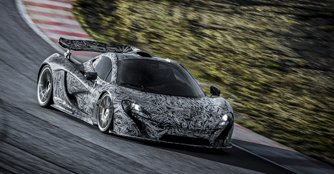McLaren P1 hypercar celebrates half a decade in pole position
02 Oct 2017|2,153 views
The McLaren P1 was conceived with one simple but extremely demanding aim - to be the best driver's car in the world on road and track. As the spiritual successor to the McLaren F1 road car of the 1990s - still widely considered to be one of the greatest supercars of all time - the McLaren P1 had to redefine not only what McLaren was capable of, but also raise the bar for the supercar world.
Five years ago, the car built to achieve this ambition was unveiled as a design study at the 2012 Mondial de l'Automobile in Paris, France. Five months later, the production version debuted at the 2013 Geneva International Motor Show.
Leveraging five decades of McLaren motorsport experience and its deep knowledge of road car engineering, the McLaren P1 represented both the birth of the McLaren Ultimate Series and a quantum leap in technology that delivered previously unknown levels of performance in a road car.
The full production run of 375 cars was sold and allocated before the first was even delivered; such was the insatiable demand for the McLaren P1. No two examples of the McLaren P1 were the same, each was custom-built to owner specification in consultation with McLaren Special Operations.
The hybrid, petrol-electric powertrain of the McLaren P1 set new standards for innovation and performance when the car was introduced. A modified version of McLaren's 3.8-litre twin-turbo V8 petrol engine, tuned to develop 727bhp, was combined with a lightweight electric motor producing 176bhp - more than double the power of the KERS unit used in Formula One at the time - to give the McLaren P1 astonishing performance.
Together, the petrol engine and electric motor produced 903bhp, resulting in a 0-100km/h time of 2.8 seconds, 0-200km/h in 6.8 seconds and 0-300km/h in 16.5 seconds - a full five seconds quicker than the legendary McLaren F1.
The McLaren P1 was conceived with one simple but extremely demanding aim - to be the best driver's car in the world on road and track. As the spiritual successor to the McLaren F1 road car of the 1990s - still widely considered to be one of the greatest supercars of all time - the McLaren P1 had to redefine not only what McLaren was capable of, but also raise the bar for the supercar world.
Five years ago, the car built to achieve this ambition was unveiled as a design study at the 2012 Mondial de l'Automobile in Paris, France. Five months later, the production version debuted at the 2013 Geneva International Motor Show.
Leveraging five decades of McLaren motorsport experience and its deep knowledge of road car engineering, the McLaren P1 represented both the birth of the McLaren Ultimate Series and a quantum leap in technology that delivered previously unknown levels of performance in a road car.
The full production run of 375 cars was sold and allocated before the first was even delivered; such was the insatiable demand for the McLaren P1. No two examples of the McLaren P1 were the same, each was custom-built to owner specification in consultation with McLaren Special Operations.
The hybrid, petrol-electric powertrain of the McLaren P1 set new standards for innovation and performance when the car was introduced. A modified version of McLaren's 3.8-litre twin-turbo V8 petrol engine, tuned to develop 727bhp, was combined with a lightweight electric motor producing 176bhp - more than double the power of the KERS unit used in Formula One at the time - to give the McLaren P1 astonishing performance.
Together, the petrol engine and electric motor produced 903bhp, resulting in a 0-100km/h time of 2.8 seconds, 0-200km/h in 6.8 seconds and 0-300km/h in 16.5 seconds - a full five seconds quicker than the legendary McLaren F1.
Latest COE Prices
September 2025 | 2nd BIDDING
NEXT TENDER: 08 Oct 2025
CAT A$119,003
CAT B$136,890
CAT C$72,501
CAT E$140,502
View Full Results Thank You For Your Subscription.



















